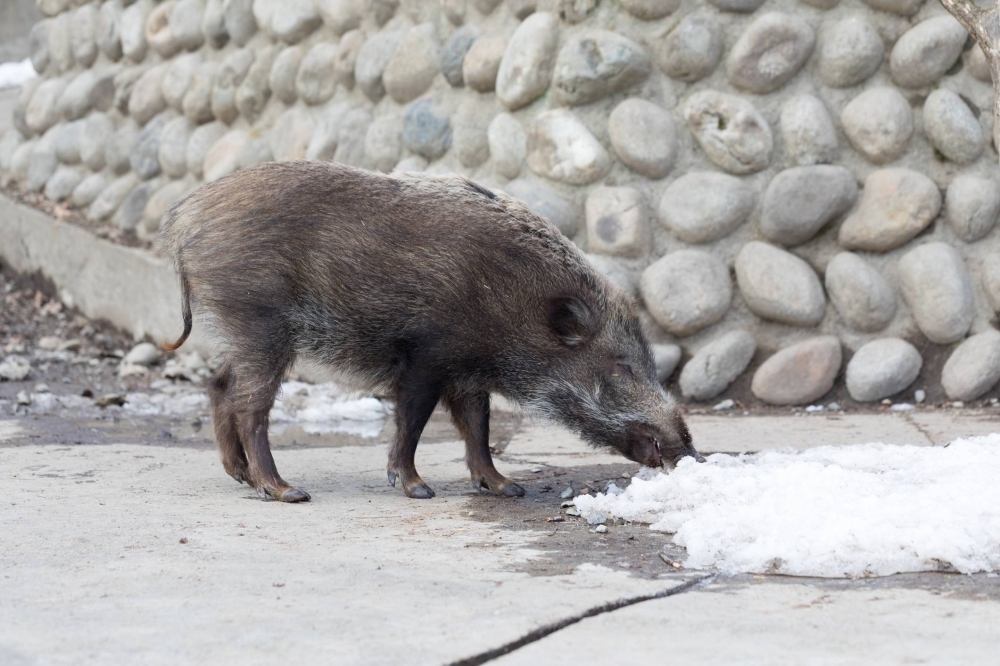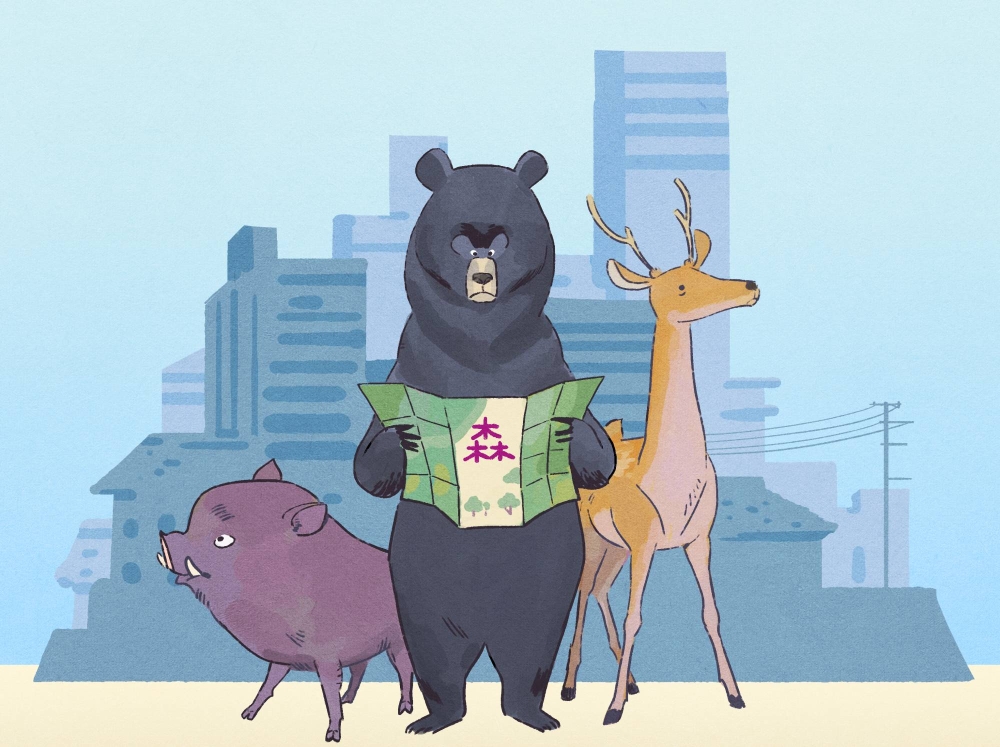At 12:14 a.m. on Oct. 25, the first report came in: A wild boar was spotted near an eight-story office building 600 meters east of Chiba Station, a bustling transportation hub surrounded by department stores and commercial high-rises.
According to more than a dozen eyewitness accounts gathered by the police in the hour that followed, the beast made its way toward a nearby 7-Eleven before heading to a junior high school across the street.
“It’s the first time I’ve heard of an inoshishi (wild boar) showing up around here,” a female clerk at the convenience store tells The Japan Times a few days after the furry omnivore made headlines.
The animal eventually wandered toward Dezu Wharf, where it injured a man in his 30s inside the grounds of an apartment complex. It also managed to ram into a taxi before trotting off into the night. Hisae Kato, an elderly local, says she heard from neighbors there were traces of blood just a block away from her home that were likely left by the wounded animal.
The final standoff took place several hours later at around 9 a.m., after police received a tip that the boar was swimming near a pier in the city’s central Chuo Ward.
As the animal scrambled back onto dry land, a group of 20 or so officers confronted it with catch poles and batons in hand. Footage captured by national broadcaster NHK shows the hog putting up a good fight, rushing toward the policemen, biting and shoving them around before being subdued by a wide net. The 42-kilogram female boar was then promptly killed and buried by the local hunting association in a forestland on the outskirts of Chiba City.

A wild boar like the one pictured here startled residents of central Chiba City last month.
| GETTY IMAGES
Boar, deer, macaques and even bears are among the many wild animals you may encounter in Japan — that is, if you’re out in the countryside. Two-thirds of the nation’s land mass is forested, after all.
However, the Oct. 25 incursion took place smack dab in the middle of Chiba City, home to nearly 1 million people in a prefecture that sits right next to Tokyo. It followed a spate of reports in recent months concerning various animal sightings — and even attacks — across towns and cities in Japan, the most frightening of which were perpetrated by bears in the northern Tohoku region, giving rise to the term “āban beā” (urban bear) as a result.
The term has become prevalent enough to be nominated as one of the year’s top buzzwords.
The urban bear phenomenon can be attributed to a variety of environmental factors such as warmer winters and seasonal fluctuations in available food. More concerning, though, is how a shrinking, graying population has led to a lack of hunters and a proliferation of abandoned farmland and deserted communities — all of which had previously acted to keep these animals at bay. Without them, the beasts have been encroaching deeper into urban areas and significantly raising the risk of violent, sometimes deadly, encounters.
“I’ve heard of wild boar sightings in the outskirts of Chiba, but never here in Chuo Ward,” says Kato, pointing toward the direction she believes the stray hog headed that night. “What in the world is going on?”
When animals attack
Four days before the wild boar fiasco in Chiba, it was a bear that had captured the media’s attention. At around 7 a.m. on Oct. 19, four residents of the city of Kitaakita in Tohoku were injured after a series of attacks by an Asian black bear, a species native to the islands of Honshu, Shikoku and Kyushu.
Also known as moon bears for the crescent-shaped white patch on their chests, among this animal’s victims was an 83-year-old woman who suffered wounds to her head, as well as a broken arm and hip. At around 11 a.m., the bear mauled a 60-year-old man, and a few hours later it ambushed a junior high school student on her way home from school, bringing the total number of victims that day to six.

An Asian black bear enjoys life at Yagiyama Zoological Park in Sendai. Recently, the same species of bear has been popping up in areas populated by people looking for food.
| KYODO
This followed another case earlier in the month in which four people were hospitalized following altercations with a bear in a residential neighborhood in the city of Akita, a prefectural capital with a population of 300,000.
Between April and Nov. 8, in fact, there were a total of 58 incidents involving 66 people harmed by bears in Akita, according to Akira Sato, an official with the prefecture’s nature conservation division. That number is tenfold compared to the mere six bear-related injuries reported the previous fiscal year that ended March 31.
“We suspect there are two main reasons behind the soaring number of bear attacks and sightings,” Sato says. “One is the animal’s expanding habitat, stemming from rural depopulation and the subsequent increase in abandoned agricultural land. That’s blurring the line between wilderness and human communities.”
The other reason, he says, is an acute shortage of acorns and beechnuts this autumn following last year’s more plentiful yield. On Oct. 20, the Forestry Agency announced the fruiting status of beech trees in the Tohoku region, noting that Aomori, Iwate, Miyagi, Akita and Yamagata prefectures all suffered poor harvests.
That’s forcing the large terrestrial animals and their cubs to venture into populated areas to scavenge for food before hibernation, Sato says. “And I hear that this could be a warm winter, which could affect hibernation patterns and see them active until later than usual.”
Meanwhile, local hunters in Akita have been culling bears at a record-breaking pace, capturing 1,167 as of Oct. 31, the day before the official bear-hunting season kicked off in the prefecture. That’s compared to 442 caught during the previous fiscal year.

The site where four people were attacked by a bear in Akita in early October.
| KYODO
Resources are limited, however, and hunters are aging along with the rest of the population. As of the end of March, the prefectural hunting association was able to count 1,473 members, over 40% of whom were age 70 or older.
In response, Akita Gov. Norihisa Satake has said he plans on introducing a bounty on the bears in his prefecture, while subsidizing the cost of bullets and transportation fees for hunting clubs.
The problem isn’t confined to Akita, though. While that prefecture has been the hardest hit, bear sightings in other urban centers are skyrocketing, and human casualties have been reported in Iwate, Fukushima, Niigata, Nagano and Gunma prefectures, among many others.
According to the Environment Ministry, the number of bear attacks hit 180 between April and Oct. 31, which included five deaths. With a month or two left before the creatures typically go into hibernation, that’s already a record, surpassing a previous high of 158 logged three years ago.
As the fall foliage and mushroom-picking season entices locals, tourists and hikers alike toward the nation’s forests and mountains, Environment Minister Shintaro Ito warned during a presser late last month to “not venture into the habitat of bears.”
The more pressing question is: How do we stop bears and other wild animals from venturing into the habitats of humans?
Blurred boundaries
In “Pom Poko,” a film produced by animation powerhouse Studio Ghibli in 1994, a community of magical shape-shifting tanuki (racoon dogs) unite to prevent a massive suburban development project in western Tokyo that cuts into their forest domain.
While their resistance is ultimately futile, the environmental fable reflects a human-wildlife conflict exacerbated by the very real urban expansion that wiped out large swaths of wilderness to accommodate Japan’s then-growing population and energy needs.
Until the 1960s and ’70s, it wasn’t uncommon to see so-called bald mountains in Japan, the result of razing forests for lumber and charcoal to fuel the nation’s rapid modernization in the early 20th century. The situation prompted a state-sponsored reforestation campaign in an effort to rebuild the country’s wood stock, measures that saw the previously dwindling population of wild animals slowly recover and, eventually, flourish and boom.
“Many bald mountains have now reverted back to forests, offering habitats for bears and other animals,” says Koji Yamazaki, a professor at the Tokyo University of Agriculture and Japan’s leading expert on the Asian black bear.
“Moreover, rural residents are aging, and many villages and settlements are depopulated or even abandoned,” he says, echoing the words of other experts. “That has led to a growing number of unused rice paddies, orchards and farmland overrun by vegetation, offering animals ample food and cover to approach human communities.”

Among the ways residential neighborhoods are trying to deter wild animals from encroaching on their land is this robotic “Monster Wolf” that was installed in Takikawa, Hokkaido.
| KYODO
The total area of unused agricultural land in Japan stood at 217,000 hectares in 1990. By 2015, that nearly doubled to 423,000 hectares, around the size of Toyama Prefecture, according to the latest available data from the agriculture ministry.
Meanwhile, the amount of cultivated acreage stood at 4.32 million hectares as of July last year, steadily falling since peaking at 6.09 million hectares in 1961. The nation’s pool of farmers are dwindling with age as well. In 2020, there were 1.36 million farmers, down 39% from 2005 figures. Among them, a whopping 70% were 65 or older.
In Japanese, there’s a concept known as satoyama (“sato” means village and “yama” means mountain), which refers to the border area between the foothills of mountains and arable flatland. It’s essentially a place where rural villagers and nature have been able to coexist for centuries, a neutral zone held together by agriculture, secondary forests, reservoirs and channels.
It’s here where depopulation has really hit. Many of these “front-line” communities are no longer capable of maintaining forests by pruning trees and keeping property clear of overgrown weeds, Yamazaki says. The number of forestry workers has also been falling, from 146,000 in 1980 to just 44,000 in 2020, according to the Forestry Agency.
While there may be limited solutions to prevent these wild animals from overrunning underpopulated mountainous communities, zoning measures to keep them out of urban centers are necessary, he says.
“But local officials and volunteers are already working past their limits,” he says, adding that this poses a substantial challenge in promoting and enacting wildlife countermeasures.
“It’s also giving animals like bears a bad reputation to the point they’re being villainized,” Yamazaki says. “Things aren’t looking good.”
Green refuges
Around four times a year, local municipal officials, volunteers and farmers gather in the district of Oyama, just outside Isehara, Kanagawa Prefecture. Their mission is to survey and maintain a long fence that has been erected between the mountains and the area’s agricultural land in an effort to keep deer and other wild animals from trespassing and turning it into their feeding grounds.
“I’ve joined them on one of these tours, and we visited a persimmon orchard that’s essentially jutting into a mountain,” says Chihiro Kase, a lecturer at Azabu University and an expert on animal behavior. “Problem is, bears can easily climb up trees bordering the fence to get over the barrier to eat the fruits. But the locals said they had no funds to cut these trees or create buffer zones.”
Such orchards and farmlands offer nutrient-rich resources for wild animals, who soon acquire a taste for it and are increasingly attracted to human settlements, thus expanding their territory. And once what used to be the first line of defense — the satoyama — is breached, Kase says, the animals begin making their way into more populous areas through patches of greenery: parks, paths, shrubs, gardens and any vegetation that offers some level of shelter.
“If this continues, human territory is going to recede and we will be increasingly outnumbered by these wild animals,” Kase says.

A wild boar runs through the grounds of a Kyoto University dormitory in 2017. Similar instances have been increasing to record highs this year.
| KYODO
Smaller animals such as tanuki, raccoons and the hakubishin (masked palm civet) can already be observed in big cities like Tokyo. Kase says the growing number of abandoned homes — estimated at around 8.5 million as of 2018, according to the latest projections available — offer an unlikely habitat for these animals, another side-effect of the nation’s demographic decline.
In the case of the wild boar in Chiba, a map of the region has led Kase and other experts to suspect that the creature emerged from the mountains east of Chiba City, approaching the city center using green spaces found in parks and schools, as well as a river that flows through the prefectural capital into Tokyo Bay.
“The number of wild boar being caught in the city is on the rise, and we’re aware that they’re coming closer and closer to the residential areas,” says Shuhei Okumura, an official of the city’s nature conservation division.
Okumura says Chiba has been setting up snare traps and supporting those interested in acquiring a hunting license, while making an effort to prevent unused farmland from becoming overgrown with shrubs.
“With the aging of the population and many residents who are older, however, there’s a limit to what can be done,” he says.
Meanwhile, reports of bear and wild boar attacks and sightings continue to flood the news. On Nov. 1, a man in his 20s was hospitalized after being attacked by a wild boar in Fukuyama, Hiroshima Prefecture. On Nov. 3, a man in his 60s saw a group of 12 or so black bears in a buckwheat farm in Kazuno, Akita Prefecture. And on Monday morning, a man in his 40s was mauled in his face and back while checking a bear trap he had set up in Shibata, Niigata Prefecture.
There appears to be no instant remedy to the sudden surge in hungry wild mammals, except to be wary and stay prepared for surprise encounters. Demand for bear bells, sprays, portable radios and even fireworks is on the rise, with sales of such products at a Komeri Power home center in the Odate, Akita Prefecture, rising three-fold compared to an average year, according to the store’s manager.
As Akita Prefecture’s website reads, “Anyone, anytime, anywhere, is at risk of encountering a bear this year” — a warning that is increasingly resonating with people across the country.

A sign warns hikers that they are entering bear territory.
| GETTY IMAGES
What to do if you encounter a bear
Japan’s mountains are teeming with wildlife and a recent spate of bear attacks in human-populated areas has many wondering what to do if they encounter one. Akita Prefecture has published a list of tips to keep residents safe:
- If a bear is seen in the vicinity of a village, contact the municipality and share the information with the community
- Mow down weeds and bushes around farmland and houses to improve visibility
- Do not leave food scraps, waste crops, rice bran, livestock feed or other materials that bears can eat outside
- Enclose farmland with electric fences to prevent bears from scavenging for food and entering the community
When hiking, Akita suggests taking these precautions:
- Do not venture into areas where mountain entry is prohibited
- Avoid going alone
- Be sure to take your trash back home with you
- If you encounter a bear that is aggressively approaching you, such as one that has taken your belongings or is following you, be sure to report the incident to the local government or police and share the information
Finally, here’s what you should do if you encounter a bear:
- Slowly back away and keep your distance from the bear and quietly leave the area. Do not run away with your back to the bear
- If you are about to be attacked, bear repellent spray (strong pepper spray) is effective in keeping the animals away. If you do not have any bear repellent spray, adopt a defensive posture in order to protect your face, neck and stomach to prevent a fatal wound

